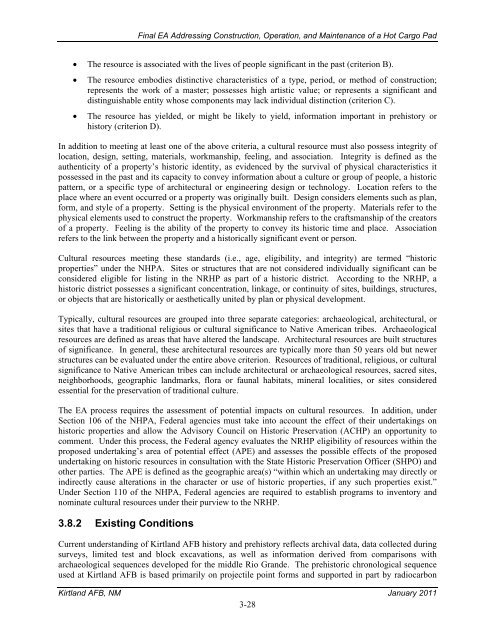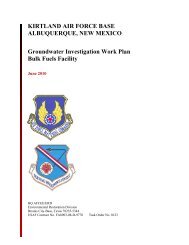Final FONSI and EA for hot cargo pad on Kirtland AFB - Kirtland Air ...
Final FONSI and EA for hot cargo pad on Kirtland AFB - Kirtland Air ...
Final FONSI and EA for hot cargo pad on Kirtland AFB - Kirtland Air ...
Create successful ePaper yourself
Turn your PDF publications into a flip-book with our unique Google optimized e-Paper software.
<str<strong>on</strong>g>Final</str<strong>on</strong>g> <str<strong>on</strong>g>EA</str<strong>on</strong>g> Addressing C<strong>on</strong>structi<strong>on</strong>, Operati<strong>on</strong>, <str<strong>on</strong>g>and</str<strong>on</strong>g> Maintenance of a Hot Cargo Pad<br />
<br />
<br />
<br />
The resource is associated with the lives of people significant in the past (criteri<strong>on</strong> B).<br />
The resource embodies distinctive characteristics of a type, period, or method of c<strong>on</strong>structi<strong>on</strong>;<br />
represents the work of a master; possesses high artistic value; or represents a significant <str<strong>on</strong>g>and</str<strong>on</strong>g><br />
distinguishable entity whose comp<strong>on</strong>ents may lack individual distincti<strong>on</strong> (criteri<strong>on</strong> C).<br />
The resource has yielded, or might be likely to yield, in<str<strong>on</strong>g>for</str<strong>on</strong>g>mati<strong>on</strong> important in prehistory or<br />
history (criteri<strong>on</strong> D).<br />
In additi<strong>on</strong> to meeting at least <strong>on</strong>e of the above criteria, a cultural resource must also possess integrity of<br />
locati<strong>on</strong>, design, setting, materials, workmanship, feeling, <str<strong>on</strong>g>and</str<strong>on</strong>g> associati<strong>on</strong>. Integrity is defined as the<br />
authenticity of a property’s historic identity, as evidenced by the survival of physical characteristics it<br />
possessed in the past <str<strong>on</strong>g>and</str<strong>on</strong>g> its capacity to c<strong>on</strong>vey in<str<strong>on</strong>g>for</str<strong>on</strong>g>mati<strong>on</strong> about a culture or group of people, a historic<br />
pattern, or a specific type of architectural or engineering design or technology. Locati<strong>on</strong> refers to the<br />
place where an event occurred or a property was originally built. Design c<strong>on</strong>siders elements such as plan,<br />
<str<strong>on</strong>g>for</str<strong>on</strong>g>m, <str<strong>on</strong>g>and</str<strong>on</strong>g> style of a property. Setting is the physical envir<strong>on</strong>ment of the property. Materials refer to the<br />
physical elements used to c<strong>on</strong>struct the property. Workmanship refers to the craftsmanship of the creators<br />
of a property. Feeling is the ability of the property to c<strong>on</strong>vey its historic time <str<strong>on</strong>g>and</str<strong>on</strong>g> place. Associati<strong>on</strong><br />
refers to the link between the property <str<strong>on</strong>g>and</str<strong>on</strong>g> a historically significant event or pers<strong>on</strong>.<br />
Cultural resources meeting these st<str<strong>on</strong>g>and</str<strong>on</strong>g>ards (i.e., age, eligibility, <str<strong>on</strong>g>and</str<strong>on</strong>g> integrity) are termed “historic<br />
properties” under the NHPA. Sites or structures that are not c<strong>on</strong>sidered individually significant can be<br />
c<strong>on</strong>sidered eligible <str<strong>on</strong>g>for</str<strong>on</strong>g> listing in the NRHP as part of a historic district. According to the NRHP, a<br />
historic district possesses a significant c<strong>on</strong>centrati<strong>on</strong>, linkage, or c<strong>on</strong>tinuity of sites, buildings, structures,<br />
or objects that are historically or aesthetically united by plan or physical development.<br />
Typically, cultural resources are grouped into three separate categories: archaeological, architectural, or<br />
sites that have a traditi<strong>on</strong>al religious or cultural significance to Native American tribes. Archaeological<br />
resources are defined as areas that have altered the l<str<strong>on</strong>g>and</str<strong>on</strong>g>scape. Architectural resources are built structures<br />
of significance. In general, these architectural resources are typically more than 50 years old but newer<br />
structures can be evaluated under the entire above criteri<strong>on</strong>. Resources of traditi<strong>on</strong>al, religious, or cultural<br />
significance to Native American tribes can include architectural or archaeological resources, sacred sites,<br />
neighborhoods, geographic l<str<strong>on</strong>g>and</str<strong>on</strong>g>marks, flora or faunal habitats, mineral localities, or sites c<strong>on</strong>sidered<br />
essential <str<strong>on</strong>g>for</str<strong>on</strong>g> the preservati<strong>on</strong> of traditi<strong>on</strong>al culture.<br />
The <str<strong>on</strong>g>EA</str<strong>on</strong>g> process requires the assessment of potential impacts <strong>on</strong> cultural resources. In additi<strong>on</strong>, under<br />
Secti<strong>on</strong> 106 of the NHPA, Federal agencies must take into account the effect of their undertakings <strong>on</strong><br />
historic properties <str<strong>on</strong>g>and</str<strong>on</strong>g> allow the Advisory Council <strong>on</strong> Historic Preservati<strong>on</strong> (ACHP) an opportunity to<br />
comment. Under this process, the Federal agency evaluates the NRHP eligibility of resources within the<br />
proposed undertaking’s area of potential effect (APE) <str<strong>on</strong>g>and</str<strong>on</strong>g> assesses the possible effects of the proposed<br />
undertaking <strong>on</strong> historic resources in c<strong>on</strong>sultati<strong>on</strong> with the State Historic Preservati<strong>on</strong> Officer (SHPO) <str<strong>on</strong>g>and</str<strong>on</strong>g><br />
other parties. The APE is defined as the geographic area(s) “within which an undertaking may directly or<br />
indirectly cause alterati<strong>on</strong>s in the character or use of historic properties, if any such properties exist.”<br />
Under Secti<strong>on</strong> 110 of the NHPA, Federal agencies are required to establish programs to inventory <str<strong>on</strong>g>and</str<strong>on</strong>g><br />
nominate cultural resources under their purview to the NRHP.<br />
3.8.2 Existing C<strong>on</strong>diti<strong>on</strong>s<br />
Current underst<str<strong>on</strong>g>and</str<strong>on</strong>g>ing of Kirtl<str<strong>on</strong>g>and</str<strong>on</strong>g> <strong>AFB</strong> history <str<strong>on</strong>g>and</str<strong>on</strong>g> prehistory reflects archival data, data collected during<br />
surveys, limited test <str<strong>on</strong>g>and</str<strong>on</strong>g> block excavati<strong>on</strong>s, as well as in<str<strong>on</strong>g>for</str<strong>on</strong>g>mati<strong>on</strong> derived from comparis<strong>on</strong>s with<br />
archaeological sequences developed <str<strong>on</strong>g>for</str<strong>on</strong>g> the middle Rio Gr<str<strong>on</strong>g>and</str<strong>on</strong>g>e. The prehistoric chr<strong>on</strong>ological sequence<br />
used at Kirtl<str<strong>on</strong>g>and</str<strong>on</strong>g> <strong>AFB</strong> is based primarily <strong>on</strong> projectile point <str<strong>on</strong>g>for</str<strong>on</strong>g>ms <str<strong>on</strong>g>and</str<strong>on</strong>g> supported in part by radiocarb<strong>on</strong><br />
Kirtl<str<strong>on</strong>g>and</str<strong>on</strong>g> <strong>AFB</strong>, NM January 2011<br />
3-28
















